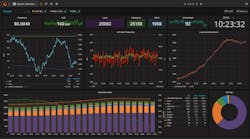During the investigation into the Aug. 14, 2003, Mid-West/Northeast blackout, it became obvious that we needed higher-resolution time synchronized data for event analyses. Since then, the widespread production use of synchrophasors has been providing deeper insights for both post-event analyses and into the operation and control of the grid. Synchrophasors are precise grid measurements available from monitors called phasor measurement units (PMUs). Measurements are taken at high sample rates (typically 30 observations per second), over 100 times faster than conventional SCADA technology. The analyses of these data have led to the discovery of new forced and natural oscillations to better observability into distributed energy resources (DER) supply.
In late 2009, the American Recovery and Reinvestment Act began pumping what would become $300 million in public and private investment toward improvements in synchrophasor installations across the United States. At that time, the Grid Protection Alliance (GPA) was established as a not-for-profit entity to provide open source software to the electric industry, as well as to maintain the synchrophasor software developed and open sourced by the Tennessee Valley Authority. This synchrophasor software is now in production throughout North America and the world.
While small, GPA has had some big successes in building collaborative efforts within the electric industry and among Government agencies. GPA is currently working on its fourth major project with the Department of Energy (DOE) to advance grid security and the use of synchrophasors – all with open source software products at their core.
GPA offers open source products to collect (openPDC, SIEGate, and the substationSBG); distribute (Synchrophasor Stream Splitter and the Gateway Exchange Protocol); store (openHistorian); and analyze (openECA and PDQ-Tracker) synchrophasor data. GPA is currently working with 26 partners, including 12 utilities and 10 other vendors, to develop and demonstrate a new protocol to more reliably and efficiently transfer large-volumes of streaming synchrophasor data. With funding from these partners and DOE, a new protocol called the “Streaming Telemetry Transport Protocol” or STTP will be demonstrated late this year at utilities in both the Western and Eastern interconnections. The specification for the protocol is being developed in the open on GitHub (www.github.com/sttp).
Open Source Software
Open source software makes up a large part of today’s computing fabric and forms a critical backbone for enterprise software systems. With open source software, start-up risks and costs are reduced as there is no vendor or technology lock-in, and the Department of Homeland Security believes it is more secure since “there are more eyes on the code.” Open source software can be tested in-situ prior to making business commitments and can be easily adapted to meet changing requirements.
“From the beginning, our objective at GPA was to produce high-quality, production grade systems that lowered the entry barriers and promoted the wide-spread use of new techniques and technologies like synchrophasors,” says Terry Boston, who was the first Chair of the North American SynchroPhasor Initiative (NASPI) and one of the Founders of GPA. To that end, GPA software is available under a permissive open source license that allows use, modification, and development of derivate products. Innovation in GPA products is fast-paced and continuous and is not bound by the business constraint of planning for the release of the next software version. Technology is moving too quickly for the utility industry to be stuck in a rut of software functionality and feature improvements that come along two or three times a decade.
As an example of this fast-paced development, in working with our utility clients, we learned that a relatively new, open source dashboard called Grafana® was not only sufficiently performant to handle large-volumes of high-resolution synchrophasor data but that it fully lived up to its billing as “the open platform for beautiful analytics and monitoring.” GPA responded by developing a Grafana® plug-in for the GPA openHistorian and, in partnership with a utility, deployed a plug-in for a commercial historian as well. In January 2018, GPA released a new version of the openHistorian that includes an internally hosted webserver so that displaying and manipulating phasor data with Grafana® is as easy as pointing your web browser at it.
Disturbance Analysis
In addition to synchrophasors, GPA develops software for analysis of event-based disturbance data. From the inception of the development of GPA’s disturbance product suite in 2012, the primary objective has been: (1) to create an enterprise-ready collection of tools to make power quality and disturbance data available for use by many corporate business units and (2) to automate the process of evaluation of disturbance data, either through GPA-provided analytics or analytics provided by others. This GPA philosophy of “ease of integration” is becoming increasingly more valuable as advanced analytics such as machine learning are beginning to see first use.
GPA has three production-proven open source applications to process disturbance data: (1) a field data collection system called openMIC, (2) an automation engine to analyze and store event and periodic data provided by field devices called openXDA, and (3) a display tool for event and periodic data called the Open PQ Dashboard that has been largely funded by the Electric Power Research Institute.
Grid Solutions Framework
The Grid Solutions Framework (GSF) is the foundational code library for GPA products with over 860,000 lines of actual code and 225,000 lines of structured comments spanning more than 75 assemblies.
GPA errs toward placing as much code as possible in shared GSF assemblies and as little code as possible in individual GPA products. This design philosophy enables all GPA products to benefit from improvements to the core and to be built upon code that has a broader test and use foundation thereby increasing quality and lowering costs.
The Business Model
GPA is a small software development shop that specializes in development of production-grade, open source software for the utility industry. GPA revenue largely comes through these software development services either funded by utilities or by Government and research organizations. GPA also offers maintenance services to utilities on all of its products.
What’s Next?
GPA will continue to work with utilities to improve and extend our synchrophasor and disturbance products as we continue to look for new ways for open source software to contribute to the advancement of utility technology. For example, we believe that synchrophasors can play a significant role in assuring that critical grid control capabilities are preserved in emergency situations that may arise from natural disasters or from cyber or physical attack. To do this, more capable software tools are needed at the substation level to support operators in managing electric service to an area that must be islanded. In addition, a tertiary control platform is needed to provide key situational information and open-loop control for balancing areas and reliability coordinators. This tertiary control platform could be a foundation for next generation SCADA that would leverage high-fidelity sensors and large data streams, like those from synchrophasors, to provide better and more reliable grid control.
For example, more utilities are seeking value from advanced analytics such as machine learning. GPA is looking to make it much easier for data scientists to use their standard machine learning tool-suite with the data layers provided by GPA’s products. The twenty-first century digital economy will demand that the grid be more reliable, robust, and resilient. As Government and industry make the leap from grid reliability to grid resilience, data mining and big data will be paramount in our success in building both the control systems and the grid of the future.




